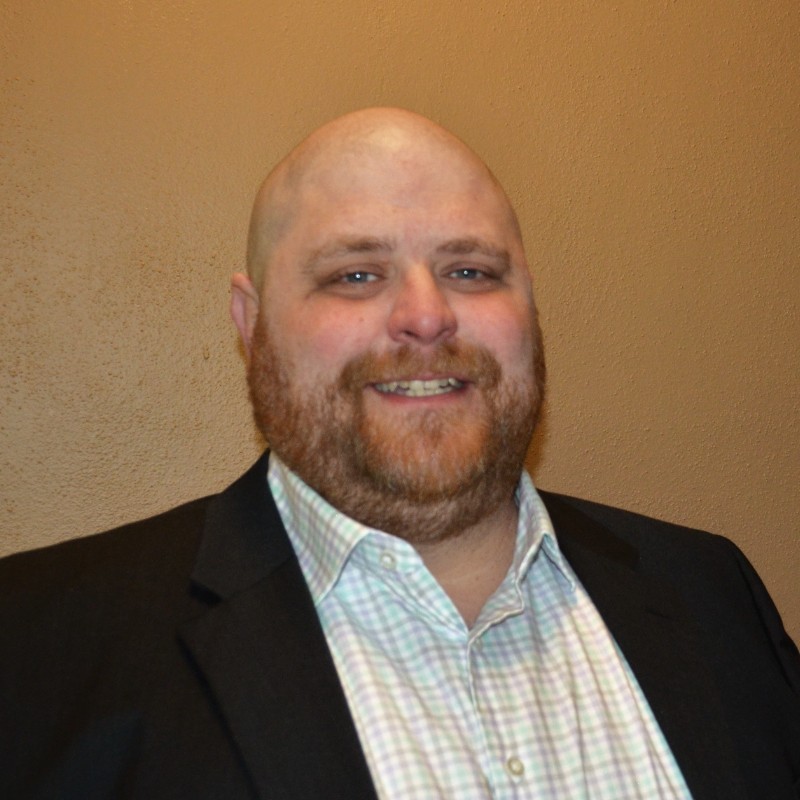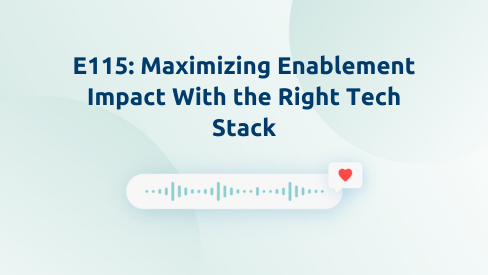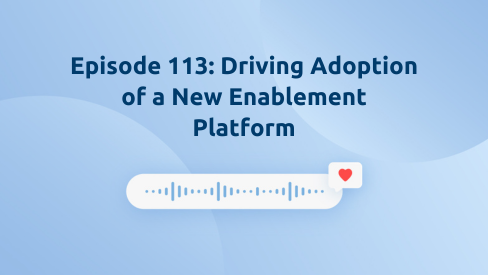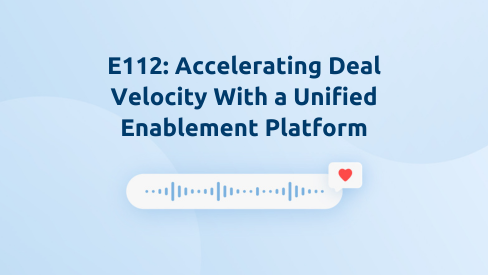According to research from Sales Enablement PRO, organizations leveraging enablement tools are four times more likely to effectively drive rep consistency. So how can you improve sales rep effectiveness through enablement?
Shawnna Sumaoang: Hi, and welcome to the Win Win Podcast. I’m your host, Shawnna Sumaoang. Join us as we dive into changing trends in the workplace and how to navigate them successfully.
Here to discuss this topic is Paul Wright, the vice president of sales enablement at Acosta Inc. Thank you for joining us, Paul. I’d love for you to tell us about yourself, your background, and your role.
Paul Wright: Absolutely. Thank you again for having me. As you mentioned, I’m the vice president of sales enablement for Acosta Group. And I’ve been in this role for a little over two years at this point. I came into this role from a subsidiary company in Acosta Group called ActionLink, where I was an account manager and had business development responsibilities, some field management responsibilities, et cetera.
I had been there for about seven or eight years prior to the move over [from ActionLink]. Before that, I’d been a visual merchandising manager for a large national retail chain. I’ve been a buyer for another large retail chain. And spent the first I’ve spent several years of my career as a district manager for a large company that has an office in Arkansas.
I’ll just say that, but so I’ve got a load of retail experience, and bringing that all into the corporate side of things has been a fun challenge for me to go from managing people to managing processes, content, training materials, and different things like that.
SS: Paul, thank you so much for joining us today. As you mentioned in your introduction, you have a lot of experience as a retail and sales leader. How does that experience influence your approach to your enablement strategy?
PW: One of the biggest helps is I know what it’s like to sell, cause I’ve done selling before. I know the challenges.
I would not consider myself even to be a seller, but I had some success in selling and learning, basically bringing all of my experience in, even from down to employee relations, and becoming a creative problem solver. Learning to hear the root cause or the root problem helps me to teach sellers how to listen for the unsaid when they’re talking to a client or a prospect. I tell people all the time, that if you ask a prospect or a client, what’s your biggest pain point you’re looking to solve? The client, especially if they’re brand new to you and you don’t have a relationship established, is not going to tell you anything because everything’s roses in their world. But if you listen and ask the right questions at the right time, you’ll find their pain points and then you present them a solution in a way that they almost think it’s their idea. When it’s their idea they’re the hero of the story, and it becomes an easy transition into closing a deal.
SS: Absolutely, I love that. What are some of your best practices then? I would love to share some tips and tricks with our audience for partnering with other leaders across the business like sales and marketing as you develop your enablement programs.
PW: Interestingly enough, at Acosta Group, I sit on the enterprise marketing team and that’s a little different I think in a lot of organizations, there’s a separate sales operations team that generally is like a deal desk, a contract desk, and an onboarding desk, things like that. But because I sit with the marketing team on the enterprise commercial team, I’ve got direct access and consistent access to the folks who are providing the content that we’re storing on Highspot, for example.
We have regular content meetings where I will bring up a point that a seller brought up to me, or they’ll bring up a point that they noticed from a piece that was more successful in a recent RFP or something like that. It becomes a collaborative process to get the right content and the best content in front of our sellers to enable them to go in confidently, knowing they’ve got what they need at their fingertips.
SS: Wonderful, I think that’s a fantastic way to establish a partnership. Now, collaboration across the business plays a key role in how you designed and launched your current Highspot environment. Can you tell us about that process?
PW: So I want to go back to the very beginning of Highspot at Acosta. The agreement was already in place to start a pilot when I came into the role. And we were in the final four or five weeks pre-launch where we were loading in content and things like that. And at that point in time, we were loading in what we thought sellers wanted. We were loading in huge capabilities decks and things like that.
And some of our marketing leaders were at our annual leadership meeting and they actually polled some of the sellers and said, what do you really want out of Highspot? We want to know why they should outsource because we are a third-party provider of services for our companies, for professional services.
And a lot of folks will say we can do it cheaper ourselves. So why should they outsource? Why should they use Acosta as their outsourcing partner? What advantage is it to do the Acosta? So our team got together and decided that we were going to create a service catalog and each service that we provide would have its own play page.
And on that play page, we would answer those questions. What is this service? Why should you outsource this service? And why should you outsource with Acosta for this service? And instead of a 35-slide capabilities deck, we had a three to five-slide overview of that particular solution. We also had a cell sheet added as part of the play page.
So send this one-pager out to measure interest. We had a spec sheet that was internal facing that answered the views and plots behind the scenes of the service and what exactly it entails. Most solutions have a brief overview video, like a 30 to 60-second jazz reel kind of thing just to get people excited about it.
Something that can be shared on social, or whatever. And then we started an on-demand training series for every solution where we get our subject matter experts on camera talking about the solution like they’re talking to a client. They will bring up in the course of this, some key listening cues, some key questions to ask, and probing questions to ask about what the solution entails, [like] what some advantages are for using Acosta for that solution, et cetera. We’ve got a user base of around 225 individuals. And with the last time I checked, which was in April, we had almost 6,000 views year-to-date of content inside of Highspot. And it was something like 17 days of view time. The challenge we’re seeing now is our users are not leveraging some of the real capabilities of Highspot.
We could have stored this content in SharePoint. We could have stored this content on a team site or anywhere else we wanted to. We picked Highspot so that we could get the advantages of the engagement metrics. And so that’s our next challenge up is how do we do that? How do we get people more engaged with using Highspot to its full capacity?
SS: It is always a journey of evolution and enablement I have to say, and this is a rapidly evolving space and you guys are doing quite well, given where you are at your stage in the journey. Now, as you were rolling out the platform to your sales team, do you have some best practices for driving some of that increased adoption that you were seeing amongst your sellers?
PW: So I really think that the initial push of doing the Highspot Heroes was a big point of that because everybody likes to be at the top of the leaderboard, especially sellers. They’re a very competitive bunch of people. And so I think that helped drive a lot of that initial early engagement. I think another thing that we did really was we had some office hours where I would just be on a team’s call for an hour once a week.
Just to answer questions and help people guide things through. I still, to this day, do a 30-minute orientation for every new user that gets added to Highspot where I walk them through the capabilities and get them acquainted with the idea of pitching at the very least. And then one of the other things, and I’ve done this for all the other parts of my job as well, is I pride myself on being accessible. So every email that I send out has a link where they can book 30 minutes with me. It’s linked to my Outlook calendar that shows them when I’m available. So they’re not overbooking or anything like that. I’m well known across the company as one of the most accessible people in support and get Teams messages all day long.
“Hey, how can I find this? How can I do that?” And I really think as enablement is a support role, I think that’s critical to be accessible and approachable to your users.
SS: Now, that’s fantastic. Paul, one area that I know you’re starting to see some traction with your sales team is engaging their buyers with Digital Rooms. What are some of your best practices for leveraging Digital Rooms today?
PW: It goes back to when I was first brought into this position, I was informed that my role was to be the easy button for sellers. So when it comes to Digital Rooms and some more advanced features of Highspot or Salesforce or anything like that, let’s make it easy.
Another term is frictionless. So we’re in the process of creating templates. We’re creating this; we’ve already created a spot where we uploaded all of our client logos so that we know they’re sending ones that are right-sized, right format, and everything like that, so it looks good. I think the worst thing you could do to a client is send them their logo and it’s pixelated or stretched or something like that.
So we’re creating that to make it easy so they can find that as they’re putting their Digital Room together to send creating some verbiage templates for a cold call or a landing page for a trade show. Or, we use Digital Rooms for a lot of different things. I’ve even used them.
For event registration pages in the past. And so the more our people see them, the more they want to use them. And the more they want to use them, the more ideas we come up with for making them easier to use.
SS: I love it and hose are some creative ideas, even some that I may apply with my own team right after this. Now, another way you’re evolving your buyer engagement efforts is through a relatively new capability in Highspot, Autodocs. What are some of the ways your teams have just started to leverage these?
PW: We are truly in the early days of Autodocs. In fact, the senior director for brand and I sat in on the webinar last week and we were messaging each other back and forth on Teams during the whole thing and she was like, “This is speaking to my soul. I feel like I’ve been seen.” So we are, right now, putting together a pilot program for Autodocs for our users. It’s still taking shape, we’re identifying a small group of people to roll it out to first. And these would be the folks that are our most active pitchers right now.
So we see them as early adopters. And so we will put together one or two Autodocs that are our highest profile services that are most frequently accessed and pitched and get this pilot group up and running. And if you ask me this question in say 60 days, I think I’ll have a lot more information to provide to you, but we are truly building that runway while the plane’s going down.
SS: Oh, absolutely. You gotta start small, but once you get those pilot users leveraging it and loving it, I hope that it does take off. So we’ll circle back in a few weeks and check in on you on that front. Now, I know buyer engagement isn’t the only part of your strategy that’s been evolving, and you’ve been driving innovation through your use of AI or artificial intelligence. How are you utilizing AI in your enablement programs?
PW: So we have all the AI features available in Highspot right now turned on for our users. I’m a firm believer of letting AI do the things it can do so that I can do the things it can’t. And the thing that it can do is it can craft an email message that introduces a document. What it can’t do is make sure it’s using my voice. So I can go in and edit that message then to sound like me and not sound like a machine. I’m a big believer in the co-pilot program from Microsoft. As a company, we’re piloting that this year in a small group of users, and I’m part of that.
And some of the other hats that I wear at my job, I’ve used that to write flows for Salesforce. And take what would have taken me four, five, or six hours to figure out, [it takes] 15 minutes to enter the prompt, get step-by-step instructions, and have a working flow. Once again, let it do the things it can do, and let me focus on what it can’t.
That’s going to be my approach for AI for as long as I can see it because it’s such a powerful tool that we’re, truly, as a society, just scratching the surface [of] what it can do.
SS: Well said, well said. Now, Paul, I have to give you credit. You have driven some fantastic results at Acosta. And I know that you guys have even seen through a lot of your amazing enablement programs and initiatives a correlation to an increase in quota attainment and win rates. How, from your perspective, has your enablement approach impacted these results, and how have you leveraged Highspot to help?
PW: I don’t want to take all the credit for it, but sales enablement was a new position at Acosta when I came in two years ago. So prior to that, the sellers had been on their own. One of the areas we saw was they were keeping track of their pipeline, as an example, on Notepads, in OneNote, or somewhere that was not consolidated. No visibility whatsoever. Every little micro team had their own SharePoint site. There was no version control on content or anything. When we started loading in those big capabilities, we noticed logos that were two generations old and just cringe stuff. Nobody was doing it intentionally or with malintent, there was just nobody herding the cats.
The biggest thing that I can take credit for is when I take a step into a role, I own the role. And my role was to get CRM usage up. So we went from having a virtually non-existent Salesforce pipeline to today, we have a robust pipeline that if we only got realistic win rate numbers on, we would be winning, and we have improved our attainment in our quota attainment and win rate.
And Highspot has really been a part of that. Our EVP of business development is one of our loudest champions. He wants all content that goes to a prospect or a client to come out of Highspo. He said, “No more of this. If you want to download it because you’re worried about presenting it in a place with spotty internet, that’s fine. But when you download it, it gets used one time. And then you consider that version is old from then on. You get your content out of Highspot for every new pitch, [and] every new presentation.” That has been critical. Our marketing team is small but mighty and they have some of the most intense brand guidelines, and I say that in a good way. They are fantastic stewards of our brand and they do a great job of spotting when something becomes outdated. We do regular audits of our content to make sure that we don’t have information that’s three years old in there still. And one of the ways we’re doing that is we’re taking that on-demand training that I mentioned earlier to the next level.
I’ve got a project manager helping me and we’re putting together a three-tier accreditation for each of our sales solutions. And tier one is that on-demand video with some questions for understanding. Tier two takes all of our sales content, pulls out nuggets and key points, and puts it into an interactive module using Rise Articulate.
And then there’s a quiz for understanding level three is a scenario based on where they are. We did one for our Amazon services where they’re giving pictures from Amazon listings and they are to call out what’s wrong with them and they’re to call out what’s right with them and things like that. And at the end of this, they get a social shareable image that says “I’m accredited in full-service Amazon”, for example.
And so we’re leveraging Highspot for all of that, as both our repository for where to go to get the training and the source of our content, so that we’re teaching on the same content that they’re pitching.
SS: Paul, last question for you. As you look ahead, how do you plan to continue to evolve your enablement strategy at Acosta?
PW: Daily evolution. I have a personal mantra: get 1% better every single day. In the finance world, there’s the rule of 72 that says whatever your interest rate divides into 72 by is how quickly you’ll see a double return. A 1% improvement means that you will be 100% better in 72 days.
It doesn’t mean you’d be perfect, it doesn’t mean you’d be an expert, you’ll be a hundred percent better than your starting point. So I am constantly on the lookout for webinars that increase my knowledge and understanding of enablement and what is out there to help people. And we’re looking at doing more of a drip-type campaign with Highspot like we did in the early days and some retraining and reintroducing of these features because honestly, the the methodology and the features have changed pretty significantly in the last two years in Highspot themselves.
And if our sellers are intimidated because it’s called something different, then I need to take that intimidation away. And help them make it easy for them to see that a Digital Room is as easy as anything they’ve done in the past. I continue to look out as well for ways that AI can be brought into the whole deal.
In my Salesforce platform, I’m looking to add in opportunity measurement, or grading, and different things like that to help our sellers see from the beginning when they’ve got something good. To continue to go after what’s good and maybe let the other stuff go by the wayside. Focus on what’s winnable, what’s achievable, and what’s impactful to the business.
SS: I love that approach, and a very interesting statistical approach to improvement. Thank you so much for joining us today, Paul. I appreciate the time.
PW: Thank you for having me.
SS: To our audience, thank you for listening to this episode of the Win Podcast. Be sure to tune in next time for more insights on how you can maximize enablement success with Highspot.




